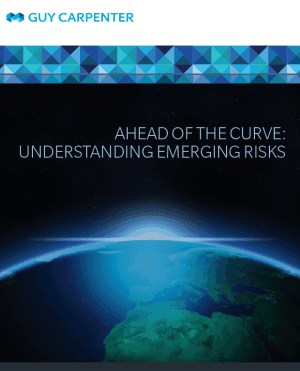
One of, if not the, most serious risks to economic and national security facing the globe’s governments are cyber attacks, according to Guy Carpenter.
The reinsurance broker in a new report said expenses to a breached company can be “exceptional” from loss of business, customer notifications, system recovery, reputational damage and lawsuits.
Cyber attacks also create aggregations of risk that “spread beyond the corporation to affiliates, counterparties and supply chains,” Guy Carpenter said in a statement.
READ THE REPORT: Ahead of the Curve: Understanding Emerging Risks
The cyber insurance market has evolved since it was born in 1996 to include many types of coverage but buyers remain confused about how much to purchase due to the difficulty in quantifying losses “due to the dearth of historical data for actuaries and underwriters to model cyber-related losses.” The market remains an infant—with the potential to reach as much as $2 billion in gross written premiums this year although cyber crime is said to cost global economies $445 billion annually.
One thing remains clear: coverage under standard commercial general liability policies will be harder to come by, especially after US policy revisions that include explicit exclusions.
ALSO READ: Guy Carpenter starts cyber reinsurance practice
The report highlights cyber-related risk to directors and officers. D&O liability insurance is also being affected by cyber attacks because directors and officers are facing shareholder and derivative actions alleging directors breached their fiduciary duty to have cybersecurity measures in place.
Guy Carpenter offered this advice: “Insurers willing to offer more cyber capacity need to be aware of issues such as insured use of outsourced providers, definitions or computer systems, aggregations, first-party breach response capabilities and business interruption event triggers, in the their product development.”
The broker said emerging compensation structures and terrorism are other emerging risks.
Addressing an expected question of why terrorism is included as an emerging risk, Guy Carpenter explained: “Given the growing population, regional conflicts producing a broad list of potential instigators, the expansive reach of social media for extremists spreading their messages and recruiting and the diversity of possibly attack modes to cause human and economic loss, terrorism does qualify as an emerging risk.”
Plus, there is uncertainty in the US terrorism market because Congress has yet to reauthorize the federal terrorism insurance backstop, the Terrorism Risk Insurance Program Reauthorization Act. TRIPRA, the most recent form of the Terrorism Risk Insurance Act (TRIA) first adopted in 2002, is set to expire on December 31.
“For insurers with terrorism-related risks on their books, it will be important to understand the threat and how it is evolving, the varying risk in different regions and which developments and risks are likely to emerge in the remainder of 2014 and beyond,” Guy Carpenter said.